Introduction to Main Street
In North America, ‘Main Street’ usually refers to a town or city’s primary commercial district. In England, the same area is called ‘High Street’. In Latin America, it’s called ‘Calle Principal’. In India, you might hear ‘Commercial Street’. In Dutch cities, it’s ‘Hoofstraat’.
However, for the past 40 years in the United States, the term ‘Main Street’ has taken on an additional meaning: the systematic approach to using a city’s heritage buildings as the basis for the revitalisation of the commercial district. Originally begun as a programme of the National Trust for Historic Preservation, the Main Street Approach has become, by far, the most cost-effective form of economic development of any kind in the US. More than 2,000 towns and cities of every size have utilised the Main Street Approach to bring economic life back to their commercial districts. While it began as a downtown revitalisation programme for smaller towns, the Main Street Approach has been effectively used at varying scales, specifically in neighbourhood commercial districts in large cities such as Boston, Philadelphia, Baltimore and Chicago.
The Main Street Approach is organised by work in four broad categories known as the Four Points, which are: Organisation, Promotion, Design and Economic Vitality. Organisation is the base upon which all the other aspects are built. Main Street entities are usually structured as non-profit organisations (NGO), run by a volunteer Board of Directors. The Board hires and oversees a Programme Manager who is responsible for day-to-day operations. The real work of Main Street, however, is done through volunteer members of committees structured around the Four Points – a Promotions Committee, a Design Committee and an Economic Vitality Committee. The role of the Organisation Committee is often performed by the Board of Directors. Responsibilities of the Organisation Committee includes raising funds for the organisation, recruiting volunteers, establishing an annual work plan and representing the Main Street organisation to the City Hall and the general public.
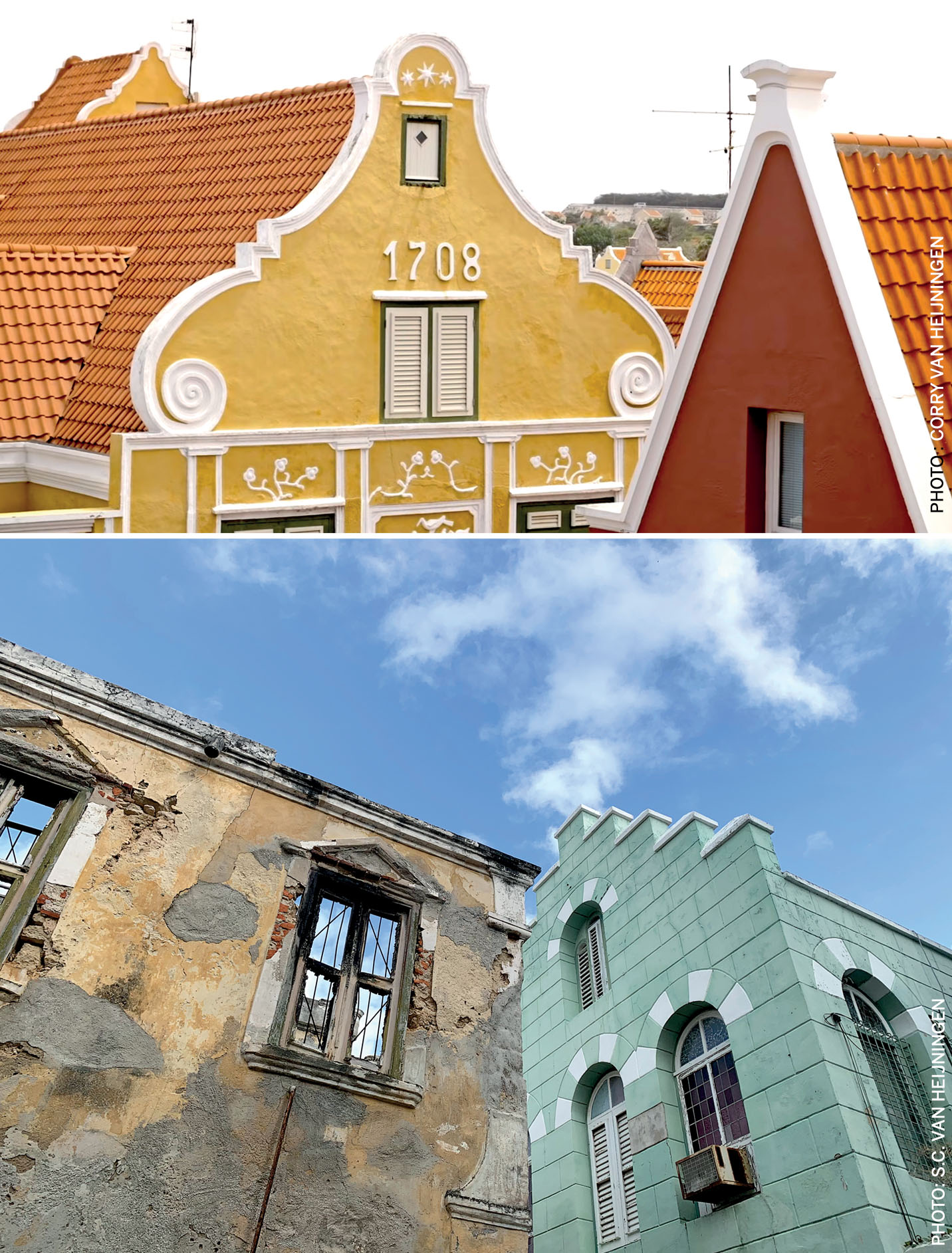
Bottom: The Basilica of St. Anne (Roman Catholic Church) in Otrobanda
The Promotions Committee is responsible for selling a positive image of the district based on authentic, creative assets of the community as well as being the marketing arm of the Main Street organisation. Arranging events is the focus of most Promotions Committees, which can include image promotions for the commercial district, coordinating retail promotions for businesses and special events. Three or four special events each year might include organising the Independence Day parade and fireworks display, coordinating an annual ethnic festival or putting on special holiday events and community heritage celebrations. When done right, such events not only draw people to the commercial district but they help change public perception by reinforcing the character and differentiation of the district.
Design is the point that is most directly related to heritage conservation. Design Committee members often provide professional design assistance to property owners making design-related decisions about their historic properties. Additionally, the Design Committee promotes or supports improvements to public spaces, weighing in on issues ranging from sidewalks, to parking, parks, lighting, street redesign and other public infrastructure projects. Many Main Street programmes administer grants and low interest loans, particularly for facade improvements; the Design Committee often serves as a design review panel to approve work those funds would be used for.
The Economic Vitality Committee is the economic development component of Main Street, with responsibilities that might include business retention and recruitment efforts, the identification of market opportunities for new and expanded businesses, advocating for incentives for development and conducting customer surveys.
The Main Street Approach has been a success because it is comprehensive. Maintaining old buildings is certainly necessary but that alone is not sufficient for revitalisation, which requires a more holistic and comprehensive approach that Main Street offers. That kind of holistic work is also incremental; it is not a quick fix solution or an instant answer. Main Street builds on the existing strengths and character of the community and works through partnerships with the local government, business and property owners and other organisations. Most importantly, Main Street is not about theory, it is about implementation.
More than 2,000 towns and cities have utilised the Main Street Approach to bring economic life back to their commercial districts
Potential to Apply to World Heritage Cities
Main Street has proven incredibly successful in small towns and large cities in the United States, but could it work as a management and economic revitalisation strategy for World Heritage Cities? There are certainly arguments against this. First is the nature of heritage resources in World Heritage Cities. To receive that designation, cities must demonstrate ‘Outstanding Universal Value,’ a threshold that few Main Street communities could reach. Second, the UNESCO oversight on World Heritage Cities carries with it the expectation of the highest levels of maintenance and robust design standards that are likely higher than is either necessary or politically acceptable in most Main Street districts. Third, while the Four Points offer a revitalisation framework, the Main Street Approach is very much a ‘bottom up’ strategy that relies on local resources and allows a large degree of flexibility in implementation. The designation and subsequent management of World Heritage Cities tends to be a ‘top down’ process, depending heavily on experts in the field rather than local citizens.
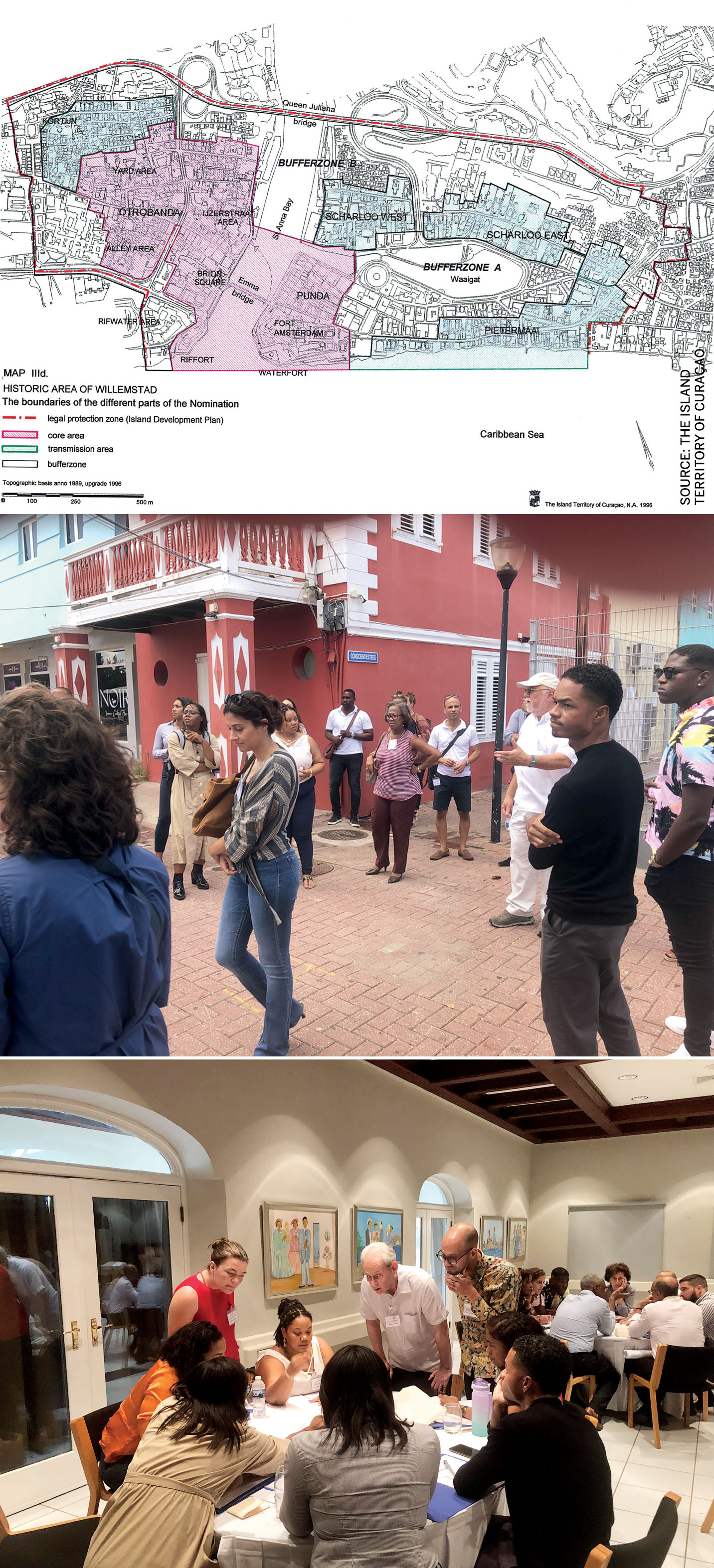
Middle & Bottom: Workshops & Masterclass conducted by Monumentfonds
Description of Masterclass Content
The Dutch Heritage Agency supported a Masterclass on Main Street in the World Heritage City of Willemstad in Curaçao partly to explore the question: ‘Could Main Street work in a World Heritage City?’. The workshop was held in coordination with Monumentfonds, a Curaçao-based, heritage-focused NGO, the Institute for Housing and Urban Development Studies (IHS) at Erasmus University in Rotterdam and the US-based consulting firm Heritage Strategies International.
Some 40 Curaçao heritage experts and advocates participated in the Masterclass, which was structured as an interactive workshop. The four-day session included an introduction to the Main Street Approach, a walking tour of the commercial areas within the World Heritage district, a half day devoted to each of the Four Points and, on the final day, group presentations on how the Main Street Approach might be applied in Willemstad.
Heritage Strategies International, with a long history of working with Main Street communities, was primarily responsible for designing and delivering the content of the course, but local experts were also brought in. Curaçao experts presented on each of the Four Point sessions, which was vital for placing the Main Street process into the local context.
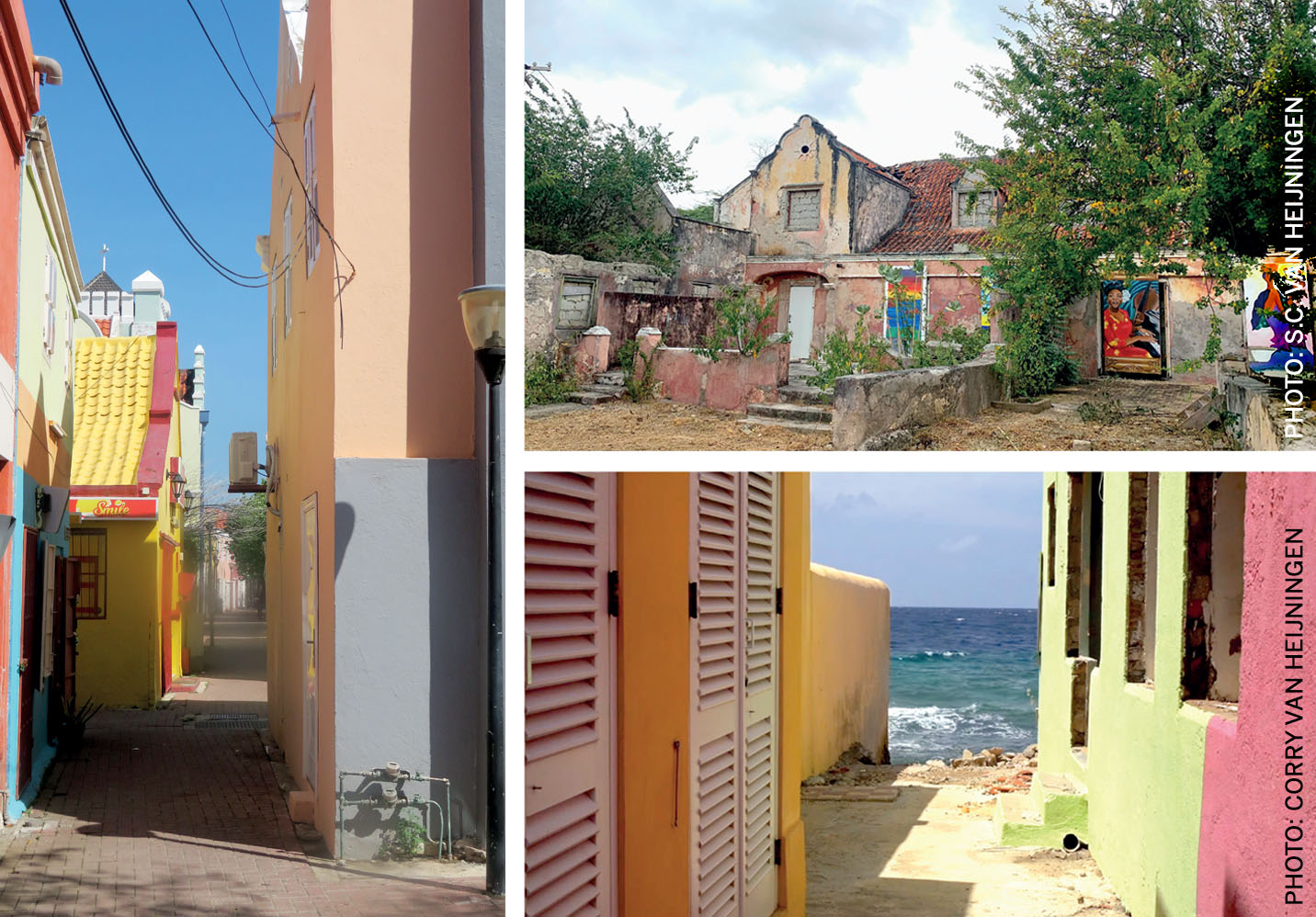
Top Right: Dilapidated building covered in local art
Bottom Right: Pietermaai alley leading to the sea
Curaçao Context
Curaçao was an interesting choice to test whether Main Street might be applied in a World Heritage context. Curaçao is a small island near the upper tip of South America, covering an area of no more than 171 square miles. The historic port town owes its existence and prosperity to its favourable geographic location and its natural harbour, the St. Anna Bay, the deep waters that both connect and separate the four historic districts that constitute Willemstad. The capital city Willemstad’s urban development began in 1634 when the Dutch West Indian Company (WIC) founded an administrative centre and trading post on the island of Curaçao. This makes Willemstad centuries older than most US Main Street communities. In essence, these elements, together with the growing multicultural community and its cultural manifestations have earned Willemstad UNESCO’s World Heritage Status, as they each demonstrate the Curaçaoan capital’s Outstanding Universal Value.
The historic inner city consists of the districts Punda, Otrobanda, Pietermaai and Scharloo, each reflecting different eras of colonial town planning, architectural qualities, and adaptations to the tropical climate, and each therefore embodying its own unique character. The historic ensemble is the manifestation of European traditions that were transferred to the New World, combined with African, American and regional influences, which over a period of three centuries created a development pattern typical of the Caribbean.
Main Street Approach is very much a ‘bottom up’ strategy that relies on local resources and allows a large degree of flexibility
To this day, almost four centuries since its establishment, the historic inner city of Willemstad remains exceptionally well preserved. Thanks to legal protection, it has retained its integrity as well as over 750 monuments, authentic in design, materials and craftsmanship. Willemstad’s world heritage enlistment in 1997, and the local protection and management structures that underlie it, continue to ensure the safeguarding of this site. This is not to say that its conservation has come without challenges or that the townscape has remained unaltered or undamaged.
Even in a well-preserved historical World Heritage City, change proves to be inevitable, whether from modern development, such as the construction of the Queen Juliana bridge, which wiped away parts of a neighbourhood in Otrobanda and Scharloo, or social-driven events like protests, such as the 30th of May strike, in which a significant number of properties in Otrobanda were burned to the ground. But perhaps some of the largest threats to Willemstad’s preservation and vitality have a more structural character, the sum of which are reflected in decaying monuments and in the continuing sharp decline of the urban population. Issues of undivided estates present a large challenge to the conservation and modern use of monuments, as most of the plots and buildings are privately owned family heirlooms. Other challenges are governmental neglect, Curaçao’s unstable political environment, a lack of monetary resources, and in many cases simply a lack of a unified vision.
This is where a programme like the Main Street, despite the high levels of maintenance and robust design standards that Willemstad’s World Heritage Status upholds, might offer new tools that could prove to be effective.
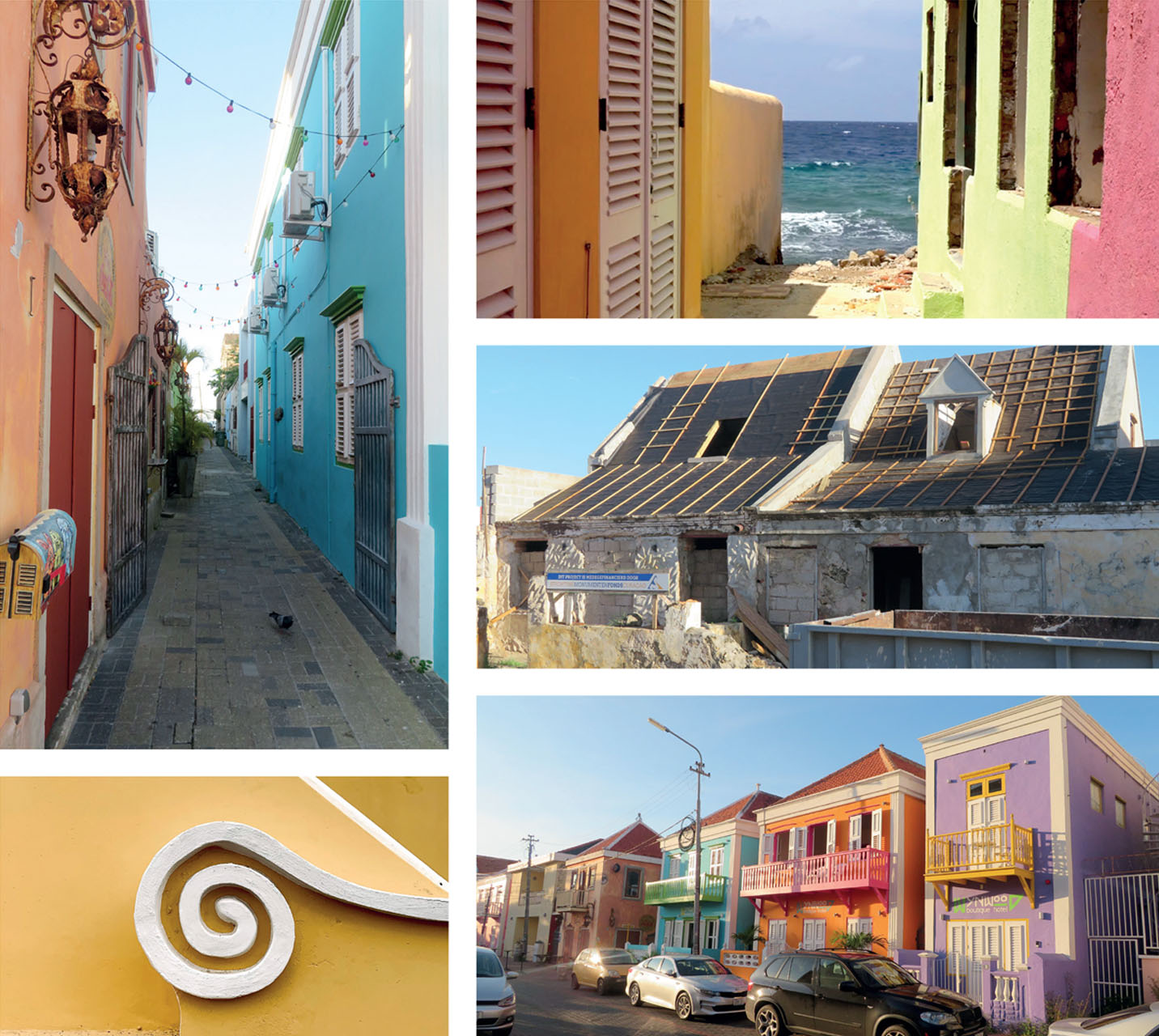
Top Right: Street in Pietermaai
Middle Right: Restoration Underway
Bottom Left: Curaçaoan Baroque detail
Bottom Right: Walkway to hotel rooms in Pietermaai
Masterclass Experience
The Main Street team provided rich and informative content, but an additional benefit of attending the masterclass was the rare opportunity to get to know the different local players in the field, which does not happen often enough on this small, yet divided, island. The 38 participants of the workshop were heritage professionals, government officials, urban planners, restoration architects and engineers, young professionals and students. Getting to know and working alongside different experts in the field was an essential and rewarding part of the workshop.
The masterclass content also incorporated the explanation of the four forces of value that affect real estate: political, social, physical and economic. Those, in just slightly modified vocabulary, are the basis of the Four Points: organisation, promotion, design and economic vitality. The workgroups were organised in this way, combining members from different professional disciplines and simulating live Main Street conditions on the spot. Treating the Four Points as equal pillars within this approach also proved to be a valuable lesson, as design and promotion tend to be overshadowed by organisation and economic vitality, creating structural imbalance in the tapestry that is Main Street.
Each workgroup was given a project area within the historic inner city to work on. An early observation made during the workshop was that, even though the project areas were each located in different areas of the districts Punda and Otrobanda, and thus functioned within a different context, they were all facing the same fate: neglect, decay and desolation.
For each of these areas, stakeholders were listed and an organisational structure was suggested, challenges for organisation, promotion, design and economic vitality were identified and solutions and recommendations were respectively presented. The latter ranged from creating attractive and safe walking routes that encouraged pedestrian traffic using innovative way-finding tools (design), to creating a brand identity for Willemstad (promotions). Acquiring startup funding to realise this vision before making it an economically self-sustaining model was also suggested (economic vitality), as was developing toolkits to create a unified awareness and potentially a vision among stakeholders that include a range of public entities, organisations, building owners, shopkeepers, business owners, residents and churches (organisation).
Though each group had a slightly different analysis and approach to tackling their area’s challenges, they all seemed to agree that catering to the local, communal and long-term needs had to be given the highest priority, as the reality is that Willemstad is currently managed by prioritising short-term, individual gains over the former. With the ever-accelerating tourism industry, tourism gentrification is an additional potential threat to this colourful capital.
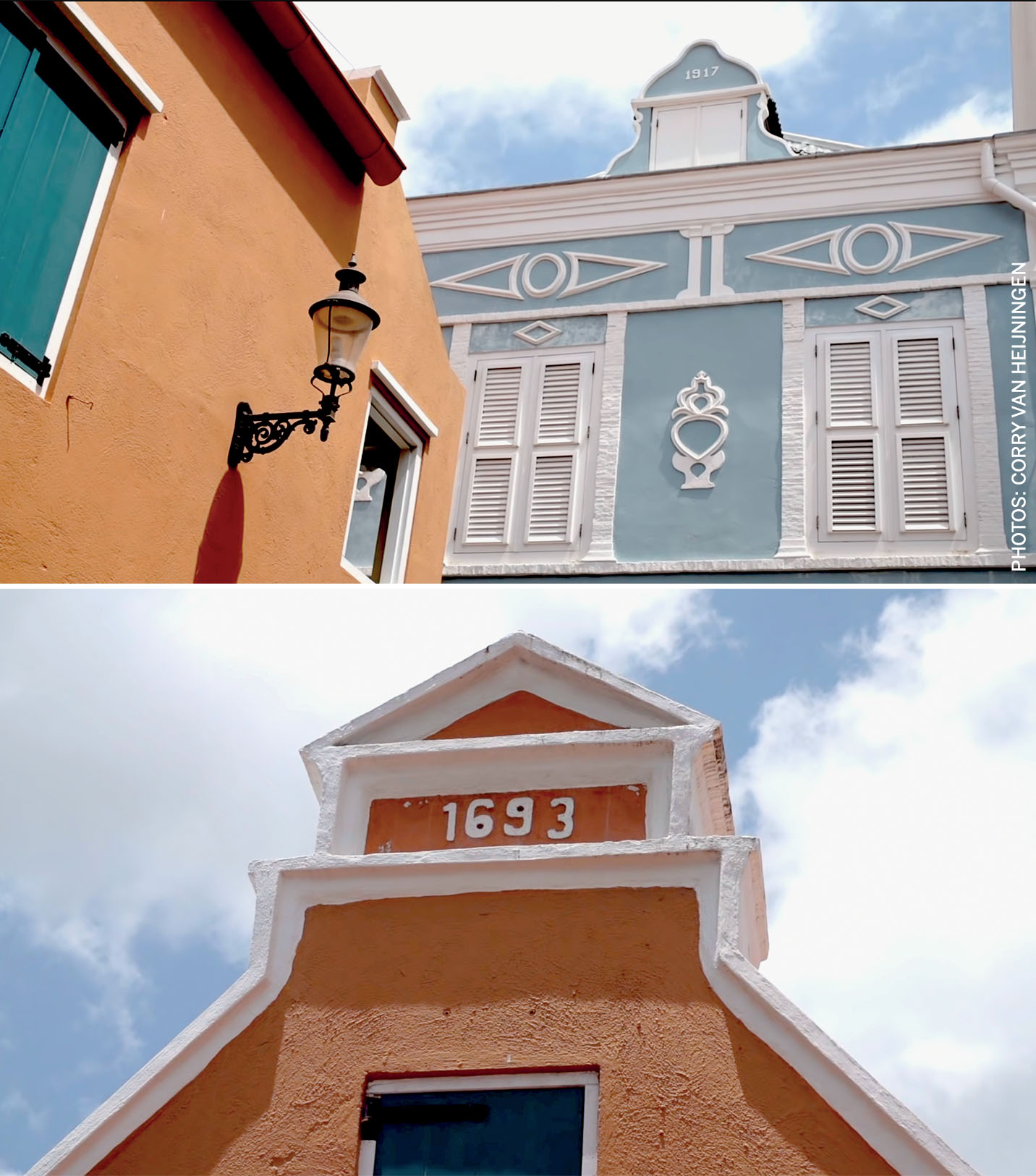
Bottom: 17th century Dutch architecture in Punda (now houses the Postal Museum).The building features a high facade with a triangular gable. The gable was topped by a small triangular fronton sitting upon a rectangular block
Potential for Main Street in Curaçao
Though the workshop did not bring about the magic solution for Willemstad’s challenges, the final presentations of the workshop proved that the analyses, visions and recommendations to revitalise the assigned areas were in the larger context shared by the different groups and were seen as a motivating power for future plans. As a next step, the Monumentenfonds Curaçao, that was the coordinator for this programme, is starting a follow-up course in which an assigned test area will be presented for development according to the Main Street approach, in collaboration with the students at the University of Curaçao, The Ministry of Traffic, Transport and Urban Planning, and the Main Street masterclass organisation committee.
Interrelated and interdependent, the Four Points of the Main Street Approach, can serve as a fresh blueprint for the revitalisation of a World Heritage City like Willemstad. Maybe the question we should be asking ourselves is not whether the Main Street Approach is transferable to a world heritage site, but whether a world heritage site can be poured into the Main Street mould, without compromising its outstanding universal value. Better yet, the existing system of laws and ordinances as a threshold that enforces high levels of maintenance and robust design standards for World Heritage Cities, can be used as underpinnings for the Four Point Approach of the Main Street.
For example, the Island Development Plan, the legal framework for evaluating plans for new building and rehabilitation in the historic inner city, specifies guidelines for planning and design within the protected area. Such an ordinance can be incorporated into the design component. Main Street’s bottom-up approach also invites everyday citizens to think about and take part in the revitalisation of their city, and rightfully so, as this multicultural community is what makes up the fiber of Willemstad’s outstanding universal value. Though top-down processes are important for the management of a site like this, they should not undermine the potential and importance of, nor discourage community-based efforts to breathe life into the people’s capital.
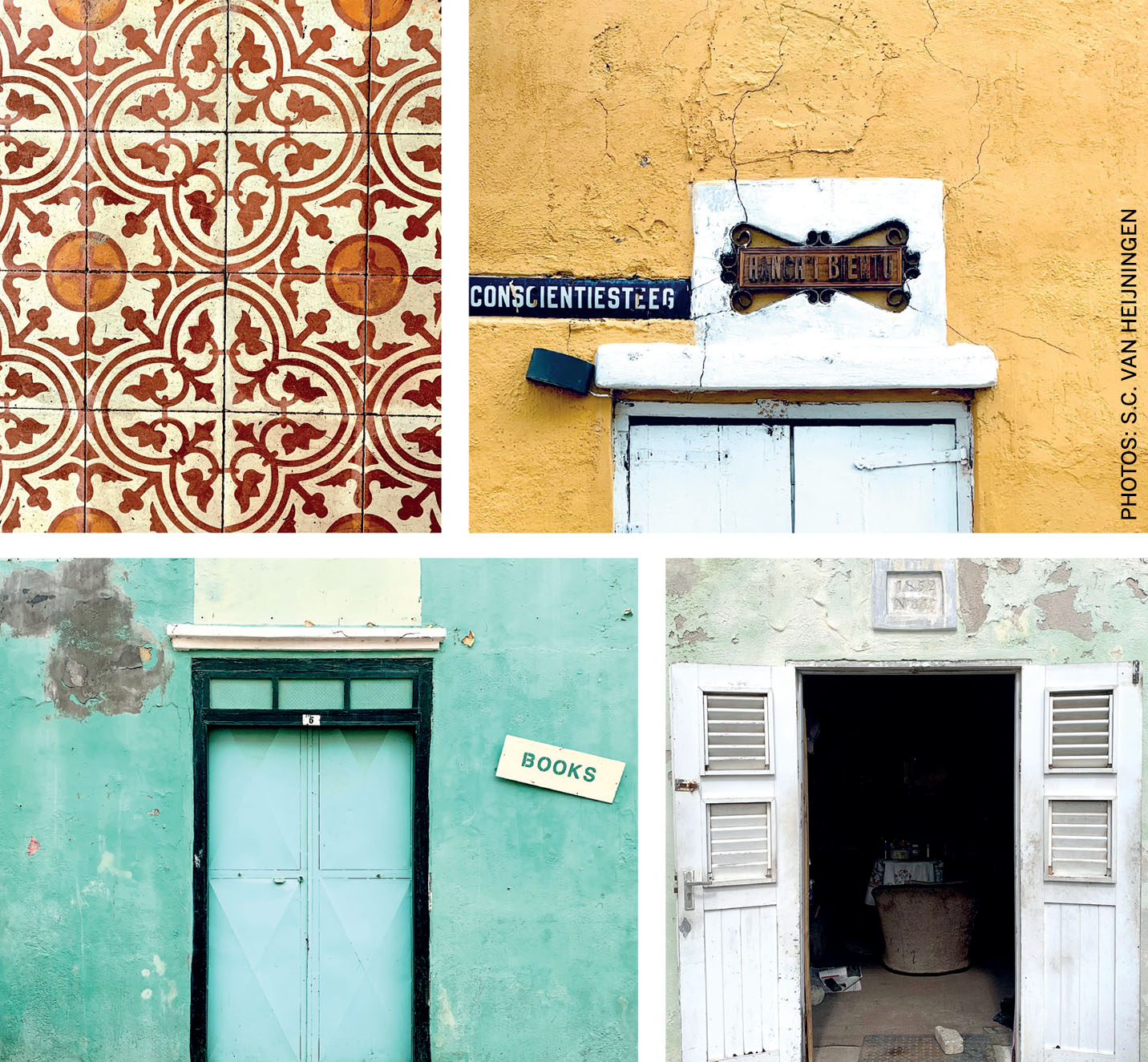
Top Right: Residence in Otrobanda, with date and number signWhere old meets new: The original name of the Conscientiesteeg, used to be Hanch’i Bientu in Papiamentu, named after the strong breeze that flows through this alley
Bottom Left: Secondhand bookstore in Otrobanda
Bottom Right: Residence in Otrobanda, with date and number sign
How the Dutch Heritage Agency/HSI/ Curaçao Collaboration came about
Decline and dilapidation of main streets and retail districts is not a uniquely US phenomenon; it is a global issue, affecting many cities across the world. In the Netherlands, many historic cities are currently suffering from retreating retail activity, empty storefronts and reduced social and economic vitality. Willemstad has similar issues. While the challenges are quite similar in different countries, the circumstances are very different, which creates an interesting space to learn. Differences urge us to reflect upon our own situation, they make us consider alternative situations and stimulate debate. In this respect differences may be more fruitful than similarities. This is, in part, what made the Cultural Heritage Agency of the Netherlands partner with the aforementioned parties on the global challenge of main street rehabilitation.
Masterclass from the Dutch Heritage Perspective
The Main Street masterclass as executed in Willemstad brought local solutions to a global challenge. The experience of the US colleagues may be applied in other parts of Curaçao and will be taken to the faraway Netherlands. They may be altered or adapted to local circumstances but will certainly enrich the toolbox and local debate. It shows once more how a global community of heritage professionals is able to tackle shared challenges in joint collaboration.
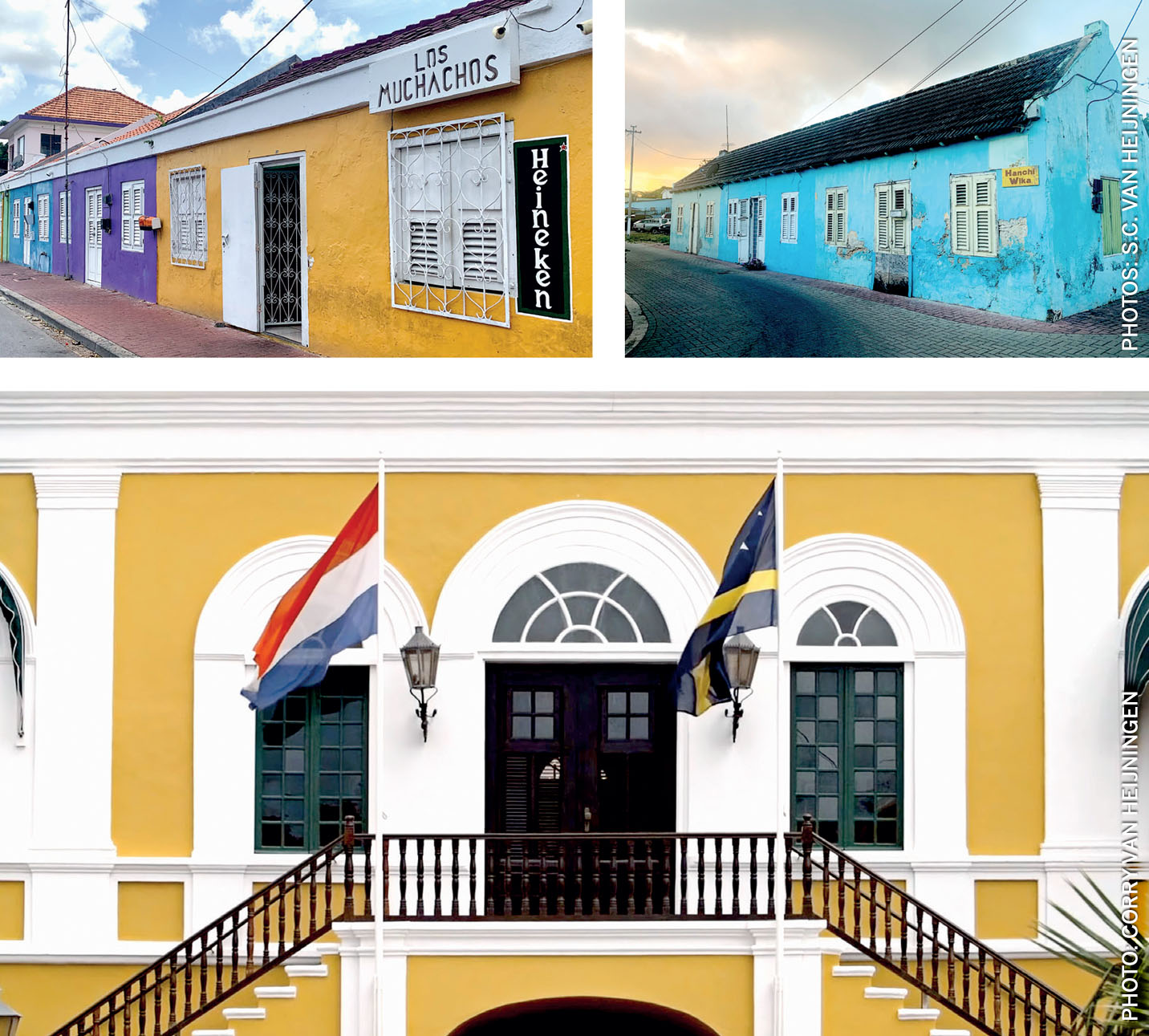
Right: Residences in deprived neighbourhood Fleur de Marie, Scharloo
Bottom: Fort Amsterdam in Punda (the oldest fort on Curaçao), with Dutch and Curaçaoan flag
Possible Transferability of Main Street Concept to other World Heritage Cities
Just like any city around the world, World Heritage Cities have to adapt to changing circumstances. A key question for each listed world heritage property thus is how to retain or gain vitality. New impulses are again and again required to support the attributes in a constantly changing world and to keep or even strengthen the acknowledged values. A programme like Main Street is a necessity to provide the conditions for conserving the site. This of course does not mean that any development and each new impulse is appropriate. So, each measure proposed should be assessed on its impact on the Outstanding Universal Value (OUV). Under these terms, the Main Street Programme is a suitable tool for all world heritage cities. As to the question of whether Main Street is really heritage conservation, the answer seems to be ‘yes’ in that it provides the basis for the stewardship of cherished heritage by creating favourable conditions and providing a future perspective.
Conclusions
Main Street has never been seen, even among its most passionate advocates, as a panacea for all of the issues of commercial districts with a concentration of heritage buildings. Nor is it a quick-fix, band aid approach. Neither is the Four Point Approach a set of handcuffs from which there can be no deviation. Main Street is simply a comprehensive framework through which multiple challenges and opportunities of heritage commercial districts can be addressed. While Main Street was invented to assist small towns in the middle of the United States, the Curaçao Masterclass demonstrated that the framework of Main Street has application far beyond its roots, including in World Heritage Cities.

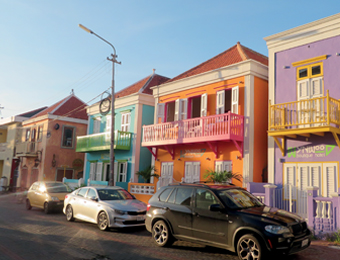

Comments (0)